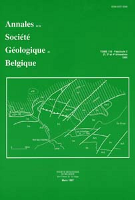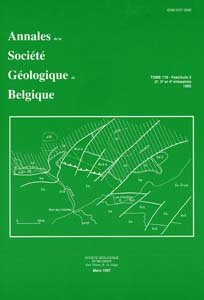- Accueil
- Volume 87 (1963-1964)
- Mémoire
- Sédimentation rythmique du Famennien supérieur dans la vallée du Hoyoux (Bassin de Dinant, Belgique)
Visualisation(s): 232 (12 ULiège)
Téléchargement(s): 127 (6 ULiège)
Sédimentation rythmique du Famennien supérieur dans la vallée du Hoyoux (Bassin de Dinant, Belgique)

Abstract
This paper describes the main features of the Upper Famennian of the « Vallée du Hoyoux » on the Northern border of the Bassin de Dinant (Belgium).
The rhythmic pattern of the sedimentation is interpreted. Macroscopic and petrographic analyses show the various aspects of the minor sequences with peculiar internal reserve graded bedding the mechanism of which is tentatively explained. These minor sequences are effectively composed of a reverse graded bedded arenaceous phase at the base and a carbonate top, in the most cases consisting in microcrystalline or cryptocrystalline dolomite. The dolomite results from a direct precipitation on the basin floor contemporaneous with the sedimentation and prior the final settling-down and burial of the sediment. But this mechanism of precipitation is often complicated by contemporaneous infiltration of conate high magnesian waters through the relatively porous arenaceous material when the argillaceous sediment on top are missing. Erosion and scouring due to a revival activity of the currents in the enclosed dolomitic basins modify and often disguise the original physionomy of the rhythmic sedimentation.
The minor sequences are the result of a progressive filling — up of the shallow — water Famennian basin. The currents are gradually compressed and the grain size increases in a parallel direction which provides a reverse graded bedding of the arenaceous phase laid down. The arenaceous sedimentation is stopped for many reasons which are explained. On their top and in very shallow-water conditions (mud cracks) takes place the dolomitic sedimentation.
The major sequences are the result of a progressive evolution of the many types of minor sequences, based on the relative competition between the detrital sedimentation and dolomitic sedimentation. The latter increases of frequence and importance on the top of the principal arenaceous phase with minor apparitions of dolomitic sediments often eroded. The arenaceous phases become recurrent but without disappearing completely, in the meantime the dolomitic phase becomes more and more important.
The all sedimentary process depends on the relative and modal velocity of the sedimentation and of the subsidence during the progressive filling-up of the basin which re-establishes the shallow-water conditions.
The subsidence is considered to be here jerky in response of successive lifting-up of the continent. The material is then displayed with a graded manner and brings the basin floor to the approximatively sea level, allowing then carbonate precipitation in restricted lagoons. This gradually and jerky filling-up of the basin is increasing to the top of the main arenaceous phase, then is more rapidly diminishing. These characteristics appear in the general reverse graded bedding of the main arenaceous phase with thin dolomitic layers, followed by a general normal graded bedding in the upper part of the major rhythms. But this decreasing of the granulometry is still formed by reverse graded beds in the thinner and recurrent arenaceous phases displayed during the dolomitic sedimentation.
The general mechanism of the Famennian sedimentation may be reported to a complex phenomenon of auto-entertained oscillations within the two types of sediments. But within the major sequences one ascertains a progressive evolution of the epicontinental shallow-water basin in the lithological nature of the material becoming more argillaceous to the top of the outcrop and also in the variation of the dolomitic carbonate being more calcitic. This latter characteristic announces the typical organogenic sedimentation which will prevail during the Tournaisian.
[Texte suivi des rapports des trois rapporteurs, pp. M47 – M51]





